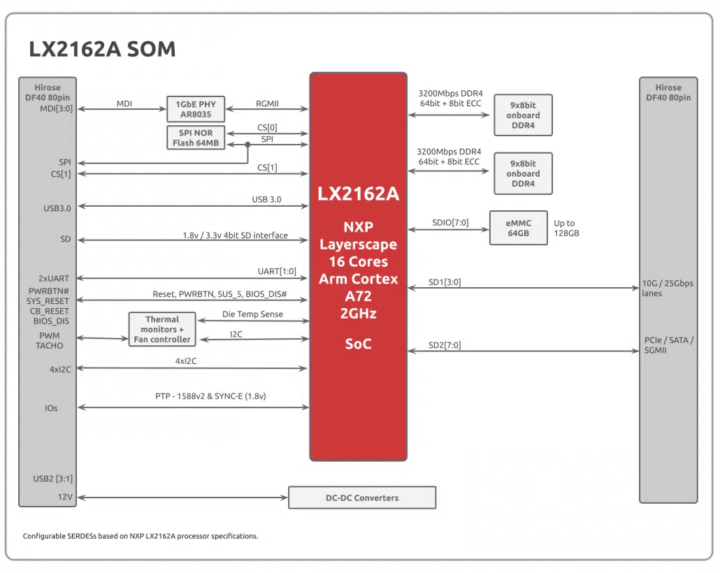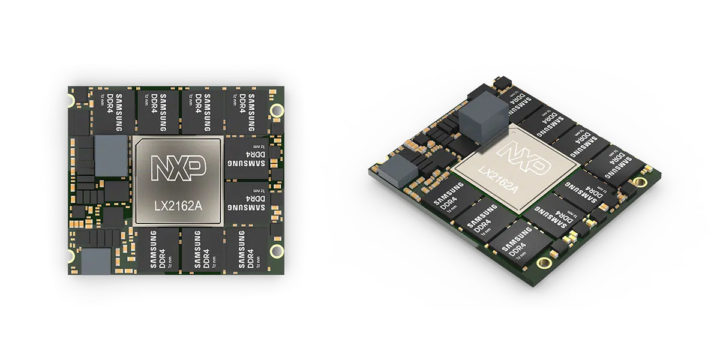SolidRun LX2162A SOM is a compact (58x48mm) system-on-module based on NXP LX2162A 16-core Cortex-A72 networking processor and equipped with up to 32GB DDR4 RAM that’s 25% of the size of the company’s earlier COM Express Type 7 computer-on-module based on NXP LX2160A 16-core Arm Cortex A72 communication processor and found in ClearFog CX LX2K networking board.
The much smaller size has been made possible by replacing the SO-DIMM sockets with soldered RAM, and switching from LX2160A to LX2162A SoC with similar features, but offered in a 23x23mm package that is nearly one quarter the size thanks to a reduction of the number of SerDes and PCIe interfaces, and manufacturing with a 16nm FinFET process technology.
- SoC – NXP Layerscape LX2162A communication processor with 16x Cortex A72 cores clocked at up to 2.0 GHz (option for the 12-core LX2122A, or 8-core LX2182A)
- Memory – Up to 32GB DDR4 single channel, with ECC (Dual-channel 64GB DDR4 is possible upon request)
- Storage – 8GB eMMC flash, 8Mbit SPI flash
- 80-pin Hirose DF40 board-to-board connectors with
- Storage
- 1x SD/MMC
- 4x SATA III interfaces
- Support for NVMe SSD (see PCIe)
- Networking
- 4x 25 GbE or 1x 100 GbE
- 4x 10GbE w/ built-in PHY
- 8x 1GbE
- Sync-E, 1588-V2 support
- USB – 1x USB 3.0 interface
- PCIe – 8x Gen 3.0 – 2 controllers
- Low-speed I/Os – 4x I2C, 2x UART, GPIOs,
- Debugging – JTAG Header
- Storage
- Supply Voltage – 12V
- I/O Voltage 3.3V/1.8V
- Dimensions – 58 x 48 mm
- Temperature Range – 0°C to 70°C (Commercial)
- Humidity (non-condensing) – 10% – 90% Humidity

Just as a comparison in terms of CPU performance, 16 Cortex-A72 cores @ 2.0 GHz and 32GB DDR4, is roughly the equivalent of four overclocked Raspberry Pi CM4 modules (50x44mm) with 8GB RAM, but done in a way that takes less than a third of the area. The comparison stops here, as the two modules target completely different markets with the SolidRun module designed for 5G base stations, high-performance CPEs, storage controller, network security, and data routing.
Solidrun is also working on the ClearFog LX2162A half-size mini-ITX carrier board for the module with two SFP28 ports (25GbE each), two SFP+ ports (10GbE each), and eight Gigabit Ethernet RJ45 ports, as well as a USB 3.0 port, and a VGA output to connect a monitor.
Considering we only get renders for the LX2162A SOM, and nothing to show for the carrier board, I don’t think the module is available right now. Eventually, more details should surface on the product page.

Jean-Luc started CNX Software in 2010 as a part-time endeavor, before quitting his job as a software engineering manager, and starting to write daily news, and reviews full time later in 2011.
Support CNX Software! Donate via cryptocurrencies, become a Patron on Patreon, or purchase goods on Amazon or Aliexpress





